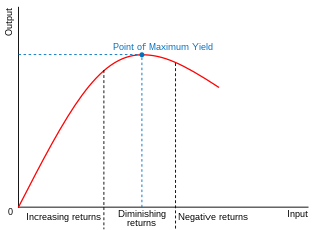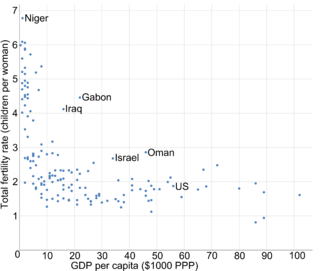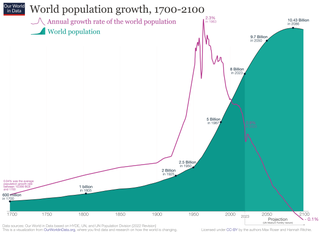
Demographic features of the population of South Korea include population density, ethnicity, education level, health of the populace, economic status, religious affiliations, and other aspects of the population.
In demography, demographic transition is a phenomenon and theory which refers to the historical shift from high birth rates and high death rates in societies with minimal technology, education and economic development, to low birth rates and low death rates in societies with advanced technology, education and economic development, as well as the stages between these two scenarios. In economic growth,the demographic transition has swept the world over the past two centuries,and the unprecedented population growth of the post-Malthusian period was reversed, reducing birth rates and population growth significantly in all regions of the world, and enabling economies to translate more of the gains of factor accumulation and technological progress into per capita income growth. The demographic transition strengthens economic growth process by three changes:(i)Reduced dilution of capital and land stock(ii)Increased investment in human capital.(iii) increased the size of the labor force relative to the total population and changed age population distribution. Although this shift has occurred in many industrialized countries, the theory and model are frequently imprecise when applied to individual countries due to specific social, political and economic factors affecting particular populations.
Ceteris paribus (also spelled caeteris paribus; is a Latin phrase, meaning "other things equal"; some other English translations of the phrase are "all other things being equal", "other things held constant", "all else unchanged", and "all else being equal". A statement about a causal, empirical, or logical relation between two states of affairs is ceteris paribus if it is acknowledged that the statement, although usually accurate in expected conditions, can fail because of, or the relation can be abolished by, intervening factors.

The dependency ratio is an age-population ratio of those typically not in the labor force and those typically in the labor force. It is used to measure the pressure on the productive population.

The total fertility rate (TFR) of a population is the average number of children that would be born to a female over their lifetime if:
- they were to experience the exact current age-specific fertility rates (ASFRs) through their lifetime
- they were to live from birth until the end of their reproductive life.

Sub-replacement fertility is a total fertility rate (TFR) that leads to each new generation being less populous than the older, previous one in a given area. The United Nations Population Division defines sub-replacement fertility as any rate below approximately 2.1 children born per woman of childbearing age, but the threshold can be as high as 3.4 in some developing countries because of higher mortality rates. Taken globally, the total fertility rate at replacement was 2.33 children per woman in 2003. This can be "translated" as 2 children per woman to replace the parents, plus a "third of a child" to make up for the higher probability of males born and mortality prior to the end of a person's fertile life. In 2020, the average global fertility rate was around 2.4 children born per woman.
Population decline, also known as depopulation, is a reduction in a human population size. Over the long term, stretching from prehistory to the present, Earth's total human population has continued to grow; however, current projections suggest that this long-term trend of steady population growth may be coming to an end.

In economics, diminishing returns are the decrease in marginal (incremental) output of a production process as the amount of a single factor of production is incrementally increased, holding all other factors of production equal. The law of diminishing returns states that in productive processes, increasing a factor of production by one unit, while holding all other production factors constant, will at some point return a lower unit of output per incremental unit of input. The law of diminishing returns does not cause a decrease in overall production capabilities, rather it defines a point on a production curve whereby producing an additional unit of output will result in a loss and is known as negative returns. Under diminishing returns, output remains positive, but productivity and efficiency decrease.

A population pyramid or "age-sex pyramid" is a graphical illustration of the distribution of a population by age groups and sex; it typically takes the shape of a pyramid when the population is growing. Males are usually shown on the left and females on the right, and they may be measured in absolute numbers or as a percentage of the total population. The pyramid can be used to visualize the age of a particular population. It is also used in ecology to determine the overall age distribution of a population; an indication of the reproductive capabilities and likelihood of the continuation of a species. Number of people per unit area of land is called population density.

Population ecology is a sub-field of ecology that deals with the dynamics of species populations and how these populations interact with the environment, such as birth and death rates, and by immigration and emigration.
In economics, crowding out is a phenomenon that occurs when increased government involvement in a sector of the market economy substantially affects the remainder of the market, either on the supply or demand side of the market.
Ansley Johnson Coale, was one of America's foremost demographers. A native to Baltimore, Maryland, he earned his Bachelor of Arts in 1939, his Master of Arts in 1941, and his Ph.D. in 1947, all at Princeton University. A long-term director of the Office of Population Research at Princeton, Coale was especially influential for his work on the demographic transition and for his leadership of the European Fertility Project.

Income and fertility is the association between monetary gain on one hand, and the tendency to produce offspring on the other. There is generally an inverse correlation between income and the total fertility rate within and between nations. The higher the degree of education and GDP per capita of a human population, subpopulation or social stratum, the fewer children are born in any developed country. In a 1974 United Nations population conference in Bucharest, Karan Singh, a former minister of population in India, illustrated this trend by stating "Development is the best contraceptive." In 2015, this thesis was supported by Vogl, T.S., who concluded that increasing the cumulative educational attainment of a generation of parents was by far the most important predictor of the inverse correlation between income and fertility based on a sample of 48 developing countries.

The ageing of Europe, also known as the greying of Europe, is a demographic phenomenon in Europe characterised by a decrease in fertility, a decrease in mortality rate, and a higher life expectancy among European populations. Low birth rates and higher life expectancy contribute to the transformation of Europe's population pyramid shape. The most significant change is the transition towards a much older population structure, resulting in a decrease in the proportion of the working age while the number of the retired population increases. The total number of the older population is projected to increase greatly within the coming decades, with rising proportions of the post-war baby-boom generations reaching retirement. This will cause a high burden on the working age population as they provide for the increasing number of the older population.
The anti-aging movement is a social movement devoted to eliminating or reversing aging, or reducing the effects of it. A substantial portion of the attention of the movement is on the possibilities for life extension, but there is also interest in techniques such as cosmetic surgery which ameliorate the effects of aging rather than delay or defeat it.

Demographically, as in other more recent and thus better documented pre-modern societies, papyrus evidence from Roman Egypt suggests the demographic profile of the Roman Empire had high infant mortality, a low marriage age, and high fertility within marriage. Perhaps half of the Roman subjects died by the age of 5. Of those still alive at age 10, half would die by the age of 50.

Population projections are attempts to show how the human population statistics might change in the future. These projections are an important input to forecasts of the population's impact on this planet and humanity's future well-being. Models of population growth take trends in human development and apply projections into the future. These models use trend-based-assumptions about how populations will respond to economic, social and technological forces to understand how they will affect fertility and mortality, and thus population growth.

Yuval Noah Harari is an Israeli author, public intellectual, historian and professor in the Department of History at the Hebrew University of Jerusalem. He is the author of the popular science bestsellers Sapiens: A Brief History of Humankind (2014), Homo Deus: A Brief History of Tomorrow (2016), and 21 Lessons for the 21st Century (2018). His writings examine free will, consciousness, intelligence, happiness, and suffering.

Scenarios in which a global catastrophic risk creates harm have been widely discussed. Some sources of catastrophic risk are anthropogenic, such as global warming, environmental degradation, and nuclear war. Others are non-anthropogenic or natural, such as meteor impacts or supervolcanoes. The impact of these scenarios can vary widely, depending on the cause and the severity of the event, ranging from temporary economic disruption to human extinction. Many societal collapses have already happened throughout human history.















